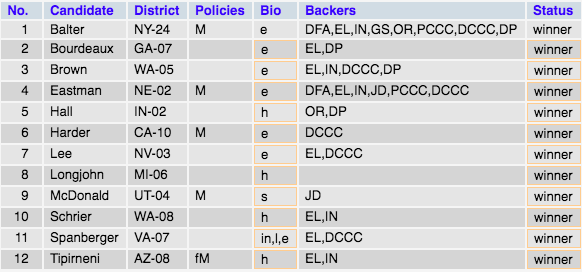“Things are more like they are now than they ever were before.” –Dwight D. Eisenhower
By Lambert Strether of Corrente
Today I want to look at some topics that came to my mind when I was working through the last midterms worksheet, “Worksheet for the 2018 Midterms (If There Is a Blue Wave, What Next for Democrats?).” All these topics concern the Democrat Party as an institution, and pertain whether 2018’s Blue Wave breaks far up on the beach (~50 seats, a possibility Democrat strategists are now discounting), breaks on the beach (23+ seats, giving control of the House to the Democrats), or breaks short of the beach (<23 seats, leaving Republicans in control of the House). Again, I should caveat that I am not looking at all House candidates, but those 80 that handicappers felt would be “in play” at the start of the primary season. Those 80, it seemed to me, is where the liberal Democratic Establishment would take its best shot. Those 80, it also seemed to me, was where, if anywhere, the left would challenge liberal Democrats, if indeed they did challenge them. There are three topics: The class composition of the Democrat Party electeds (electeds, at least, in the primaries), the success or failure of the Democratic Congressional Campaign Committee’s candidates (DCCC), and the DCCC vs. Our Revolution (OR). I’ve formulated queries for each, and the results are as you see in Figures 1, 2, and 3.
Figure 1: Composition of the Democratic Party Electeds: MILO vs. Science, Health, Education
As readers know, the World Socialist Web Site posted on the “CIA Democrats” in March 2018. For example:
Elissa Slotkin [supported by both the DCCC and Emily’s List], a former CIA operative with three tours in Iraq, who worked as Iraq director for the National Security Council in the Obama White House and as a top aide to John Negroponte, the first director of national intelligence. After her deep involvement in US war crimes in Iraq, Slotkin moved to the Pentagon, where, as a principal deputy assistant secretary of defense for international security affairs, her areas of responsibility included drone warfare, “homeland defense” and cyber warfare. The Democratic Congressional Campaign Committee (DCCC) has designated Slotkin as one of its top candidates, part of the so-called “Red to Blue” program… The Democratic leaders are promoting CIA agents and Iraq and Afghanistan war veterans. At the same time, such people are choosing the Democratic Party as their preferred political vehicle. There are far more former spies and soldiers seeking the nomination of the Democratic Party than of the Republican Party.
(More here, here, and here.) However, when I looked at my sample of 80 districts and 392 candidates, I found only 14 candidates whose bios indicated they had intelligence backgrounds. So, if the WSWS story is true for the Democrat Party as a whole, it’s not true for my sample. So I decided to broaden my criteria to “MILO” candidates (Military, Intelligence, Law Enforcement, Other). Which makes sense if you think about it, because intelligence — and especially, heaven forfend, domestic intelligence — is embedded in a matrix of all those functions; spies are surrounded by soldiers, lawyers, and other operatives of dubious provenance. Here are the successful MILO candidates in the Democratic 2018 primaries for my sample:

20 winning MILO candidates out of 80 districts (25%) is very, very impressive. For contrast, we can look at winning candidates with backgrounds in Science, Health, or Education:

Only 12 (15%). Notice also the prevalence of DCCC support for MILO candidates, compared to a scattering of DCCC support for Science, Health, or Education candidates. So, at least for my sample of battleground districts, if we agree with Thomas Frank’s thesis that the Democrats are the party of the professional classes, we can see that the composition of electeds (should these candidates be elected) will be skewed toward professional soldiers, professional spies, and professional law enforcement far more heavily than it will be toward professional scientists, medical specialists, or academics. The schwerpunkt, as it were, of the Democrat Party is, if not military, militarized.
Figure 2: The DCCC Had a Very Good Year
An even better year than punching the left in the mouth by defenestrating Ellison and purging all Sanders supporters from the Rules and Bylaws Committee would have suggested. Here are their results:

Of the winners in the 80 districts I tracked, 53 (66%) were backed by the DCCC (were, in other words, ready to spend four hours a day on the phone with donors asking for money, because that’s the price of DCCC support). The DCCC backed no losers.
Figure 3(a): The DCCC vs. Our Revolution
I wondered if there was significant overlap between the set of DCCC candidates and the set Our Revolution (OR) candidates, or whether the two sets were disjunct. Here is the answer:

There is almost no overlap; I’ve marked the five districts where OR challenged the DCCC. OR lost every time. (I don’t know why there were no challenges. I could speculate that OR didn’t feel ready, that there was a dearth of candidates, a dearth of money, that OR is less about the national level than the state and local level, or that OR and DCCC had an implicit deal not to challenge each other because checking Trump was the over-riding priority.) I don’t view these results as a rebuke to OR; far from it. OR maintains lists for the results of its campaigns for 2016, 2017, and this year (so far). Here is 2018’s.
Figure 3(b): Our Revolution
Green for winning; blue for losing:

(The winners so far are highlighted at top left.) As I’ve said, campaigning for office is very, very hard. It is a real skill, and it has to be learned by doing it; there’s no other way. Not everybody is a natural like AOC (or, it has to be said, Bill Clinton). So what OR is doing for the left is, at a minimum, developing a bench. Further, think of the candidates listed above — both green and blue — and those who participated in their campaigns, as pre-positioned outposts for 2020, outside the control of the Democrat Party apparatus. Could be useful, especially with the 2020 campaign already well underway.
This post brings me almost to the conclusion of what has been for me a very entertaining series of worksheets on the mid-terms; I’ve certainly learned a lot — often by making mistakes — about how to work with this data. I’ll have at least one wrap-up after Election Day. I hope readers have found these worksheets helpful!
UPDATE To be more clear, I regardless of where the Blue Wave breaks, I don’t expect much to be left on the shore but flotsam and jetsam. No treasure chests! Even leaving Medicare for All aside, the militarization of candidates in this sample does not inspire confidence.


Fig. 2: Didn’t the DCCC endorse some of these only after they had won their primaries?
At least Eastman in NE-02 and Balter in NY-24 defeated candidates who were not only
supported by the DCCC but on the Red-to-Blue list. So, why do these count as DCCC wins?
Or am I missing what Fig. 2 is supposed to convey?
Maybe I should rewrite that. That’s one of the weaknesses of my database this year; I don’t have a time dimension. I’m dubious that we know why candidates win unless we get granular at the district level. (Sometimes, money isn’t enough, as campaign 2016 shows.) But everybody likes to back a winner! What I thought was essential is that the candidates were willing to sign up for the four hours on the phone. Makes the ownership structure very clear.
Adding, by “a good year” I mean a good year controlling the party apparatus, which is what the DCCC cares about.
Could make timelines of the candidates campaign.
Lambert Medicare for All means little to nothing to ex-military types. Don’t they already have government VA insurance plus lush benefits? What’s the expression – “I’ve got mine *blank* you”. How much sympathy do the CIA Dems have for the underclass? I see little action by the Democrats even if they win the House other than idiotic Russiagate hearings non-stop about Trump. Who knows they can ramp up the ‘grand bargain’ again. Wasn’t Pelosi for it back in 2013?
https://thehill.com/homenews/house/288157-pelosi-open-to-obama-proposal-on-entitlement-cuts
Veterans no longer receive lifetime health care through the VA. My eldest got 5 years post-service. Got college, though, and may get a VA mortgage if he ever decides to buy a house.
My five years is up next April.
Besides Rehab and the 0% disability rating on my knee, I havent really utilized the VA.
I was fundamentally opposed to the Iraq invasion and believe that the Afghan war got derailed as a result of Iraq and incompetent political people believing Hamid Karzai was the Afghan George Washington, Thomas Jefferson, or John Adams. Instead, he turned out to be Andrew Johnson.
However, if we are going to send our troops off to fight in foreign wars, then we owe them things like VA care for life after they return. If we don’t want to budget for it, then don’t fight the stupid war. If all we have is a peacetime army, there will be fewer people to cover with less critical needs and without the budget deficit from active deployment so we can afford to cover the VA completely for life in that condition.
I didn’t know that.
Compelled to respond here that yes, veterans are still afforded lifetime healthcare under the VA system. The five years period has to do with priority given to soldiers who served in a combat zone and recently returned to civilian life. After that period ends, VA care continues but with some higher copays. Although still way more affordable than private sector and no monthly premiums.
The rub with VA health is that the overall system is likely being put on path towards privitization. This year’s VA Mission Act was passed with very high bi-partisan support and includes some administrative lingo that will likely be used to farm vets out to more expensive private care. The true debacle within VA is how many medical provider/professional positions are currently vacant. I’m not an expert on that issue, but the gut feeling is that VA internal care (more efficient, better outcomes) is being undermined by restricting funding to fill those vacancies.
Regarding whether vets and natsec stooges care about the underclass? Not so much. It’s not about “I’ve got mine” as much as their narrow minds are completely taxed in propping up their faith that the the world MUST be defended against chaos and ONLY the USA is endowed by history to do so.
In OR vs. DCCC races, you left out KS-02 where Sharice Davids, the DCCC backed candidate defeated Welder, backed by OR, Sanders, and Occasio-Cortez. In this race the DCCC and Emily’s list came in late, dropped a ton of money on Davids and beat Welder, who had been working the race from the beginning. If any body on the left thinks the DCCC and Emily’s List is your friend, think again.
Sorry, should be KS-03.
I am very disappointed about Welder’s loss and Davis’s win. Even getting to see the outrageous ads against her — not just that they highlight her history as an MMA fighter but that they imply that she supports Medicare for Everyone — makes up for it. She does not support Medicare for Everyone. She just wants to make healthcare affordable. Whatever THAT means?
The ads against her are so extreme, they almost make me think I should like her candidacy.
Davids! Sharice Davids. I goofed on her name
Short description of KS-03: https://ballotpedia.org/Kansas%27_3rd_Congressional_District_election_(August_7,_2018_Democratic_primary)
> If any body on the left thinks the DCCC and Emily’s List is your friend, think again.
Never my thought; I doubt very many readers think that.
Probably not, certainly not in your case. But it always amazes me how many people I run into that equate the Democrat party with “progressives”.
Pepsi and Coke. Nothing else is out there.
In IA-01, DCCC backing gave Finkenauer a large financial advantage over the other Democratic primary candidates.
https://www.fec.gov/data/elections/house/IA/01/2018/
Finkenauer on health care: In an August, 2017, meeting with Indivisible Iowa, she said that she supported Medicare-for-All single-payer health care and that it was the only thing that made sense. In November, 2017, she was chosen by the DCCC as a “Red to Blue” candidate. By the spring of 2018, she said we needed to “fix” the ACA and supported some sort of public option. In a response to a fact check this month (10/18), her spokeswoman said that Finkenauer believes in a “strong private insurance market with affordable plans that cover those with pre-existing conditions as well as preventive care.” Her spokeswoman has also said that Finkenauer “has been clear in supporting the addition of a public option, such as a Medicare buy-in for people under 65, as the best way to make health care more affordable.” There is no clarity on how extensive this public option would be and who under 65 would be eligible for a Medicare buy-in, while a strong private insurance market remains supported.
Finkenauer’s website reads:
“Healthcare is a human right, and extending access to quality and affordable care to every American must be a top priority in Congress. It will certainly be one of mine, and I won’t be afraid to fight for universal health care – including a public option…fighting to protect and build upon the progress we made in the Affordable Care Act toward the goals of achieving universal healthcare coverage and lowering the cost of care. I’ll fight back against all attempts to raise premiums, kick Iowans off their healthcare, or reduce the services covered by their insurance, such as annual preventive care checkups, maternity care, or addiction and mental health treatment…fighting for community health centers and critical access hospitals that serve towns and cities throughout our state, as well as making sure that funding for the vital Children’s Health Insurance Program never lapses again…”
Refs:
https://www.thegazette.com/factchecker/fact-checker-blum-largely-right-that-finkenauer-envisions-big-health-care-changes-20181016
https://www.bleedingheartland.com/2017/11/20/dccc-backing-abby-finkenauer-in-ia-01/
https://www.abbyfinkenauer.com/issues/fighting-for-access-to-quality-and-affordable-healthcare/
https://iowastartingline.com/2018/04/19/islp027-abby-finkenauer-lgbtq-youth-conference/
Finkenauer was endorsed by Biden just before the primary and was in Obama’s more recent round of endorsements.
I got a mailer of Biden endorsing Cedric Richmond last week.
Snake oil salesman
> Finkenauer
Ka-ching.
I would bet other candidates followed a very similar trajectory (thinking of Gillum, here).
“..I found only 14 candidates whose bios indicated they had intelligence…”. I am surprised that there are 14 candidates vying for Congress who have intelligence.
I have the good fortune to be in the media market that overlaps the NY-22 and NY-24 House Districts, both hotly contested by the Repubs and the Dems. As a result, it is non-stop political advertising on TV. One of my objectives is to avoid watching commercial TV for the next week except for live sporting events where they will put in the odd beer commercial between political ads. Netflix and DVDs are on tap.
Change Now, a Democrat-affiliated group has announced they are infusing $400k into Dana Balters NY-24 campaign for TV ads over the next week despite the latest polls showing her trailing Katko by about 15 points. This is a pretty inexpensive media market so $400k buys a pretty major onslaught. https://www.syracuse.com/politics/index.ssf/2018/10/democratic_group_to_spend_400k_on_ads_critical_of_john_katkos_tax_vote.html
BTW – I didn’t even realize we have a Senate race in NYS this year until last week. I don’t think I have seen a single political ad for Gillibrand or Farley over the past month.
I remember when Bernie Sanders was going to take over the Democratic Party. Looks like the opposite happened.
Well, there was a reaction to it, as well you might expect. We’ll see what 2020 brings.
The staus quo in the two parties is really the Battle of the Billionaires. Bernie Sanders doesn’t fit into the plans of the Democratic billionaires.
The disrupting thing about Trump was he upended the Republican billionaire plans by mobilizing Democrat blue collar workers to vote for him. Bernie Sanders was not able to get Republican voters or black/hispanic to swing to him en masse.
Neither Sanders nor anyone else suggested the Democrat Party could be taken over in a single election — anyone who believes that or expects it is extremely politically naive.
One note about my absolute favorite democratic candidate running for the House this year, retired Army major Richard Ojeda for WV-03. I have a hard time believing this guy will ever play the moneyball game of talking to donors. Foremost, he probably could never convincingly do it. Right now his campaign emails are scratching for an extra $50K in order to continue running ads against the millionaire corporate republican. But most of all, and after meeting him in-person, I think the guy is a legit old-school working class democrat. Watch any of his campaign ads, like the one where he puts a photo of Pelosi up right next to his opponent. Or even better, listen to this stump speech: https://www.youtube.com/watch?v=qyYpNdUVEIk
The guy has the names of a dozen or so fallen comrades tattooed on his back. He was instrumental in kicking up the West Virginia teacher’s strike. I heard him on an interview recently saying with seriousness that lobbyists should have to wear bodycams whenever they speak with elected officials. This guy does not suffer fools, especially those who think bombing/invading more countries is a swell idea. So even though I see his name alongside other clearly establishment veteran candidates like Amy McGrath for Kentucky, this is one guy I’ll risk saying is not controllable. Big hint, he publicly talks about why he voted for Trump despite being a democrat until death. All around, an incredible force of nature populist who will raise some much needed hell in Congress.